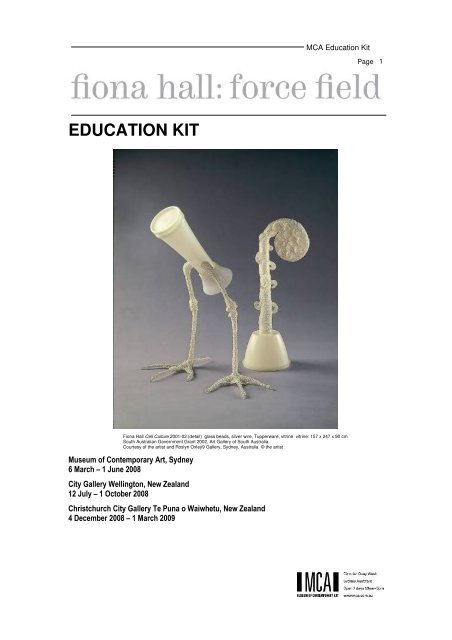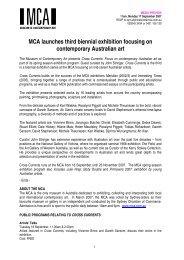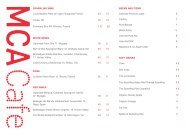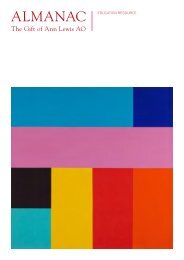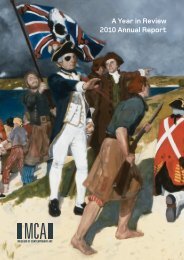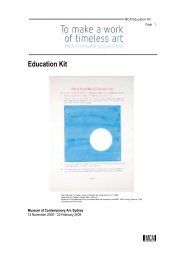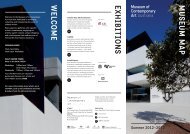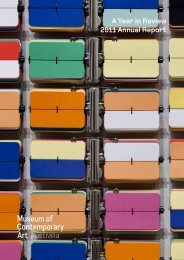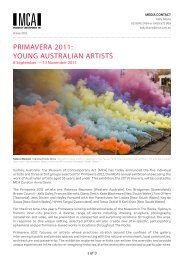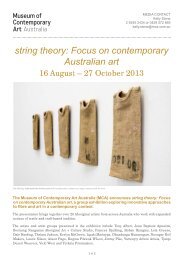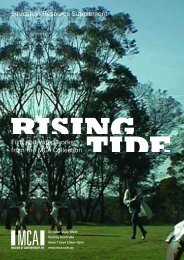Fiona Hall: Force Field Education Kit - Museum of Contemporary Art
Fiona Hall: Force Field Education Kit - Museum of Contemporary Art
Fiona Hall: Force Field Education Kit - Museum of Contemporary Art
- No tags were found...
Create successful ePaper yourself
Turn your PDF publications into a flip-book with our unique Google optimized e-Paper software.
MCA <strong>Education</strong> <strong>Kit</strong>Page1EDUCATION KIT<strong>Fiona</strong> <strong>Hall</strong> Cell Culture 2001-02 (detail) glass beads, silver wire, Tupperware, vitrine vitrine: 157 x 247 x 90 cmSouth Australian Government Grant 2002, <strong>Art</strong> Gallery <strong>of</strong> South AustraliaCourtesy <strong>of</strong> the artist and Roslyn Oxley9 Gallery, Sydney, Australia © the artist<strong>Museum</strong> <strong>of</strong> <strong>Contemporary</strong> <strong>Art</strong>, Sydney6 March – 1 June 2008City Gallery Wellington, New Zealand12 July – 1 October 2008Christchurch City Gallery Te Puna o Waiwhetu, New Zealand4 December 2008 – 1 March 2009
MCA <strong>Education</strong> <strong>Kit</strong>Page2CONTENTSIntroduction 3Ways to use this kit 3Curriculum Connections (includes Postmodernism Focus) 4Exhibition Overview 6Curatorial Intention: Key Themes 7<strong>Art</strong>work Analysis with Image, Curatorial or <strong>Art</strong>ist Practice, Focus Questions and Activities• <strong>Art</strong>work Analysis 1: Amazonical (2007) 10• <strong>Art</strong>work Analysis 2: Mourning Chorus (2007–08) 13Secondary Case Study: MCA Collection in Context – The Price is Right (1994) 17Two Post-visit Practical Activities for Primary Level• Activity 1: Soap Carving: Hybrid Creatures 18• Activity 2: Metal Embossing 20Post-visit Practical Activity for Secondary Level• Darkroom Photography Exercise: Photograms 21Additional Teaching and Learning Suggestions – Focus Questions and Activities• Primary Level 22• Secondary Level 23Glossary 26Further reading and research 27Evaluation Questionnaire: MCA <strong>Education</strong> <strong>Kit</strong>s 28Acknowledgements 29
MCA <strong>Education</strong> <strong>Kit</strong>Page3INTRODUCTIONThis online <strong>Education</strong> <strong>Kit</strong> has been producedby the <strong>Museum</strong> <strong>of</strong> <strong>Contemporary</strong> <strong>Art</strong> tosupport the exhibition <strong>Fiona</strong> <strong>Hall</strong>: <strong>Force</strong> <strong>Field</strong>in Sydney and during the exhibition tour toNew Zealand. <strong>Fiona</strong> <strong>Hall</strong>: <strong>Force</strong> <strong>Field</strong> wasorganised and toured by the MCA inpartnership with City Gallery Wellington.<strong>Fiona</strong> <strong>Hall</strong>: <strong>Force</strong> <strong>Field</strong> is a major survey <strong>of</strong>work by Australian artist <strong>Fiona</strong> <strong>Hall</strong>, bringingtogether photographs, videos and sculpturalinstallations encompassing thirty years <strong>of</strong>practice.This kit <strong>of</strong>fers an insight into <strong>Hall</strong>’s work andartistic practice, which explores theintersection <strong>of</strong> nature and culture. Keyworks in the exhibition are examined toprovide background information about thework, themes, connections and concerns in<strong>Hall</strong>’s art.A special feature is a focus on post-visitpractical art activities for primary andsecondary level.Please note: This exhibition containsartworks featuring nudity and sexualimagery. Some works may not be suitablefor younger audiences, especially Primarystudents. MCA Learning recommends thatteachers should preview the exhibitionbefore bringing classes, or contact MCALearning for further information at thebooking stages.WAYS TO USE THIS KITThis resource is intended for use by teachersand students <strong>of</strong> Primary and Secondaryclasses, as well as a general guide forTertiary and community arts audiences.The material in this kit is designed forstudents <strong>of</strong> Visual <strong>Art</strong>s and Photographic &Digital Media, but is also relevant for thestudy <strong>of</strong> English, especially for the study <strong>of</strong>Visual Literacy and History.The kit can be utilised by education groupsengaging directly with the works during theclass excursion as well as individual studyand research. The images, activities andideas can assist with pre-visit preparationand during the gallery visit, and to developpost-visit activities.The material is intended to complement theinformation provided in the exhibitionpublication, exhibition room brochure,SKETCH (a resource written by the artist for8 – 14 year olds) and SKETCH Junior foryounger audiences, MCA <strong>Art</strong>ist’s Voice andthe exhibition wall texts.Teachers are advised to adapt theseactivities to suit their students’ needs or tointegrate areas <strong>of</strong> this resource into existingclassroom units <strong>of</strong> study. Focus questionsand activities are included to stimulatediscussion and critical thinking by students,and to lead to a deeper investigation <strong>of</strong> theissues raised by <strong>Fiona</strong> <strong>Hall</strong>.Key terms are defined in the glossary at theend <strong>of</strong> this kit. A guide to additional readingand resources has been provided to assistwith further study.
MCA <strong>Education</strong> <strong>Kit</strong>Page4CURRICULUM CONNECTIONSTeachers are encouraged to adapt syllabuslinks from the list below to suit the system <strong>of</strong>their school’s state or their country. Usethese suggestions as a starter for planning,or talk to MCA Learning staff for furtherideas.For senior students in New South Wales,<strong>Fiona</strong> <strong>Hall</strong>: <strong>Force</strong> <strong>Field</strong> is an ideal context todevelop Case Studies, investigating <strong>Art</strong>ist’sPractice or Curatorial Practice and looking atapproaches to photography, sculpture andinstallation. The study <strong>of</strong> the exhibition in the<strong>Museum</strong> environment during the class visitto the MCA provides a valuable opportunityto look at the Conceptual Framework, andstudy the Frames through engaging with theworks <strong>of</strong> art, or to look at the development <strong>of</strong>a Body <strong>of</strong> Work.<strong>Fiona</strong> <strong>Hall</strong>’s research approaches, range <strong>of</strong>historical and contemporary sources, andconnections to global and intimate themesmeans the exhibition is an excellentopportunity for the study <strong>of</strong> the PostmodernFrame.See the Focus Questions and Activitiessections for further syllabus-linked teachingand learning ideas.Visual <strong>Art</strong>s/Creative <strong>Art</strong>s• The role <strong>of</strong> the <strong>Contemporary</strong> <strong>Museum</strong>• Working in series, developing a Body <strong>of</strong>Work• Postmodernism (see below for furtherdetails)• Conceptual Framework—<strong>Art</strong>ist, <strong>Art</strong>work,Audience, World• Exposure to a range <strong>of</strong> artistic practice• Diversity <strong>of</strong> media and techniques• <strong>Art</strong> and politics, art and current events• <strong>Art</strong>ist’s Practice• Identity and self• <strong>Art</strong> History, <strong>Art</strong> Criticism• The role <strong>of</strong> the body in contemporary artpractice• Feminist perspectives• Appropriation and recontextualisation• <strong>Art</strong> and politics, art and current events,art and personal histories• Narrative in art• Critiquing the Role <strong>of</strong> the <strong>Museum</strong>(Historical and <strong>Contemporary</strong>)Postmodernism Focus:<strong>Fiona</strong> <strong>Hall</strong>: <strong>Force</strong> <strong>Field</strong> connects to the HSCVisual <strong>Art</strong> Postmodern Frame through:• The Body / Gender politics• Postcolonialism/Colonial history• The domestic and the everyday• Politics, Consumer culture, Global trade• Collaboration• Appropriation and recontextualisation• Language and text• Fluidity, multiple readings andinterconnectedness (the exhibition title<strong>Force</strong> <strong>Field</strong> refers to overlappingenergies and ideas)• Examining and critiquing systems <strong>of</strong>trade and exchange• Humour and irony• Critique <strong>of</strong> museums and museologicaldisplay, especially the impulse tosystematise and classify• <strong>Art</strong> which pushes or crosses boundariesand territories• <strong>Art</strong> which is challenging and provocativeEnglish• Analysing Visual Texts• Oral and research skills• Response to visual stimuli• Creative writing and response• Critical essays and reviewsPhotographic & Digital Media; Timebased<strong>Art</strong>s• Allusions to popular culture including film• The photographic portrait• The place <strong>of</strong> photography in the canon<strong>of</strong> art and art history• Photography as documentation – truthand artifice
MCA <strong>Education</strong> <strong>Kit</strong>Page5• The moving image – video andinstallation• Multimedia presentationsAustralian History• Post colonialism, colonialism andcontactSociety and Environment• Visual arts as a reflection <strong>of</strong>contemporary culture• Visual arts as a reflection <strong>of</strong> cultural orpersonal identity• Ecology – plants, animals and ecologicalprocesses <strong>of</strong> Australia and othercountriesPUBLICATION<strong>Fiona</strong> <strong>Hall</strong>: <strong>Force</strong> <strong>Field</strong>This new 96 page publication, co-publishedby City Gallery Wellington and <strong>Museum</strong> <strong>of</strong><strong>Contemporary</strong> <strong>Art</strong>, features essays byVivienne Webb (MCA) and Greg O’Brien(City Gallery Wellington), an interview withthe artist and Paula Savage (City GalleryWellington) and full colour plates.Available from MCA Store, RRP$39.95/MCA Members $31.96ESL/NESB/CALD• Developing a visual arts vocabulary list• Written and oral responses• Cultural identity and issues in the visualarts• Australian culture and historyMCA EDUCATION PROGRAMSTo book a group visit to the MCA to view<strong>Fiona</strong> <strong>Hall</strong>: <strong>Force</strong> <strong>Field</strong>, or for information oneducation programs and services linked tothis exhibition please contactMCA Learning education@mca.com.au 029245 2484 or www.mca.com.au/education<strong>Fiona</strong> <strong>Hall</strong> in Guyana, 2007
MCA <strong>Education</strong> <strong>Kit</strong>Page6EXHIBITION OVERVIEW<strong>Fiona</strong> <strong>Hall</strong>: <strong>Force</strong> <strong>Field</strong>At the core <strong>of</strong> <strong>Fiona</strong> <strong>Hall</strong>’s work is theintersection <strong>of</strong> nature and culture. Over thepast four decades her art has focussed onthe natural world—its complex processes aswell as its wonders—and in recent years hasreflected an increasing concern at the impact<strong>of</strong> humans upon it.Like a ‘force field’ <strong>of</strong> conflicting energies,<strong>Hall</strong>’s art is shaped by the histories <strong>of</strong>colonisation, systems <strong>of</strong> knowledge, and theethics <strong>of</strong> consumption. Her sources rangefrom the historical to the contemporary, andfrom the global to the domestic, drawingupon literature, politics, finance, media,science, sexuality, gardening andmetaphysics. Her art negotiates theboundaries between competing interests andexerts a subtle yet precise engagement withthem.the last decade that chart the overlappingterritories <strong>of</strong> power, politics and theenvironment. Some reflect <strong>Hall</strong>’s recentinterest in camouflage—defence patternstaken from nature and adapted for militarypurposes. Others weave together narratives<strong>of</strong> global trade and colonial history, <strong>of</strong>enlightenment and exploitation.<strong>Fiona</strong> <strong>Hall</strong>: <strong>Force</strong> <strong>Field</strong> aims to reveal a kind<strong>of</strong> archaeological layering <strong>of</strong> the artist’sformal and conceptual concerns, as well ascontinuities in her practice over time. Notonly is her work remarkable for theconsistency <strong>of</strong> its ideas and interests, butalso for its relentless pursuit <strong>of</strong> new artisticpossibilities and its capacity to engage withshifting social and environmental conditions. 1This exhibition presents an in-depth survey<strong>of</strong> works from the 1970s to the present. Bornin Sydney and based in Adelaide, <strong>Hall</strong> beganworking with photography but has extendedinto diverse media including sculpture,installation, moving image and gardendesign. Her work is characterised by its use<strong>of</strong> ordinary objects and materials, which aretransformed into complex and allusive artworks.The exhibition is divided into zones whereworks from different phases <strong>of</strong> <strong>Hall</strong>’s careerare brought together. The works in thisgallery date from the 1980s and 1990s andexplore aspects <strong>of</strong> the domestic realm andconsumption. The adjacent section revolvesaround ideas <strong>of</strong> the body. Another selectionon this level reflects upon connectionsbetween various life forms, while at thecentre <strong>of</strong> the exhibition is a group <strong>of</strong> worksthat explore humanity’s relationship to natureand our concepts <strong>of</strong> Paradise. Themezzanine level features works largely fromHoldfast (Macrocystic angustifolia) 2007tin, aluminium 27.5 x 27.2 x 2 cmCourtesy <strong>of</strong> the artist and Roslyn Oxley9 Gallery, Sydney, Australia© the artist1 MCA introductory wall text, 2008
MCA <strong>Education</strong> <strong>Kit</strong>Page7CURATORIAL INTENTIONS: KEYTHEMES<strong>Fiona</strong> <strong>Hall</strong>: <strong>Force</strong> <strong>Field</strong> is curated into sixdifferent thematic ‘chapters’ or ‘zones’ whereworks from different phases <strong>of</strong> the artist’scareer are brought together in a galleryspace.Presenting her art in this way reveals thediversity yet consistency across her earlierand recent practice. This allows theaudience to discover a kind <strong>of</strong> archaeologicallayering <strong>of</strong> her formal and conceptualconcerns and to trace the artist’s artisticdevelopment or re-investigations. Not only is<strong>Hall</strong>’s work remarkable for the continuity <strong>of</strong>her ideas and interests, but also for itsrestless pursuit <strong>of</strong> new artistic possibilitiesand its capacity to re-engage with shiftingsocial and environmental issues.Focus Questions:• Suggest three alternative themes tocurate <strong>Fiona</strong> <strong>Hall</strong>’s works into.• Which other works by <strong>Fiona</strong> <strong>Hall</strong> could fitinto some <strong>of</strong> these themes?• Make a list <strong>of</strong> works which crossbetween themes. Which is the work orseries <strong>of</strong> works which connects to themost themes?• Investigate other ways you could curate<strong>Fiona</strong> <strong>Hall</strong>’s artworks. For example:chronologically, by media or by methodand materials. Make an illustratedexhibition floorplan and curatorialstatement to support your ideas.• Interview a member <strong>of</strong> your class or amember <strong>of</strong> the public to discover theirresponse to this curatorial concept.1. Domestic/ConsumptionThe exhibition opens with a suite <strong>of</strong> worksdating from the 1980s and 1990s thatexplore ideas <strong>of</strong> the domestic realm. While‘home is where the heart is’, it is also a zonein which the material, emotional and spiritualaspects <strong>of</strong> life jostle, clash and sometimesachieve a tentative equilibrium. The ethicsand politics <strong>of</strong> daily life take shape throughthe forms <strong>of</strong> familiar household items –everyday, throw-away materials reflectingthe many decisions and rituals <strong>of</strong>consumption.Featured works:The price is right (1994)Medicine bundle for the non-born child(1994)Give a dog a bone (1996)The Social Fabric (1996)2. Symbiosis/InterrelationsAnother grouping <strong>of</strong> works exploresconnections between diverse life forms. Alertto the extraordinary capabilities <strong>of</strong> animalsand plant life, their precise adaptations andintricate interaction, <strong>Hall</strong>’s art frequentlyechoes the workings <strong>of</strong> the natural world andthe processes <strong>of</strong> adaptation and interactionshe observes there. Humans are drawn intothe mutually supportive and, at times,competitive relationships between species:insects; plants; marine organisms. We arenot external to, but enmeshed within thecomplex and delicate web <strong>of</strong> the naturalworld.Featured works:Holdfast (Macrocystic angustifolia) (2007)Dead in the water (1999)Insectivorous (2006)Castles in the air <strong>of</strong> the cave dwellers (2007)Amazonical (2007)3. BodyBoth early and recent works reflect <strong>Hall</strong>’salertness to the body not only as somethingsexual, vulnerable and a part <strong>of</strong> ‘nature’, butalso as a political and complex entity. The
MCA <strong>Education</strong> <strong>Kit</strong>Page8body is a site shaped by influences andconcepts from the surrounding world,including the media, morality, science andreligion. Yet the physical form also embodiesa sensual, experiential knowledge and thisdisjunction provides a dynamic within <strong>Hall</strong>’swork. Witty, playful and even shocking, thesecreations tease and provoke our sense <strong>of</strong>privacy and propriety.Featured works:Pupa (2005)Syntax <strong>of</strong> flowers (1992)Scar Tissue (2003–04)Manly Beach (1985)Collaroy Beach (Eko and Max Pam) (1985)Words (1990)Morality dolls – the seven deadly sins (1984)4. Paradise / NatureAt the centre <strong>of</strong> the exhibition is a group <strong>of</strong>works that explore humanity’s relationship tonature and concepts <strong>of</strong> Paradise. Severalseries <strong>of</strong> works revolve around humanity’sage-old desire for harmony with nature andfor a return to the Garden <strong>of</strong> Eden. In <strong>Hall</strong>’sart, conflicting systems for understandingand controlling the natural world compete forour attention. Botanical Latin, vernacular andindigenous languages propose competingframeworks for knowing and classifying thebiodiversity around us. Although nature iscentral to culture, religion and science, it isultimately owned and contained by none.Featured works:Paradisus Terrestris (1998–2005)Occupied Territory (1995)Cell Culture (2001–02)Paradise (1984)5. TerritoryA number <strong>of</strong> works chart the overlappingterritories <strong>of</strong> power, politics and theenvironment. Some reflect the artist’s recentinterest in camouflage–defence patternstaken from nature and adapted for militarypurposes, which has infiltrated our daily livesthrough media reportage <strong>of</strong> terrorism andwarfare. Several works are dedicated to thedisappearance <strong>of</strong> species and thedegradation <strong>of</strong> bio-systems. Throughmapping the convergence <strong>of</strong> human andnature, <strong>Hall</strong> reflects upon what we have lostalready and what we still stand to lose.Featured works:Mourning Chorus (2007–08)Tender (2003–05)Amnesiac’s Cartography (Narrow Road,Deep Chasm) (2007)Mire (2005)Breeding Ground (2007)Stronghold (2008)Leura, New South Wales (1974)6. TradeThis section includes works from the lastdecade <strong>of</strong> <strong>Hall</strong>’s practice which weavetogether narratives <strong>of</strong> global trade andcolonial history, <strong>of</strong> enlightenment andexploitation. This room is encircled by thesweeping scope <strong>of</strong> <strong>Hall</strong>’s ongoing majorwork When my boat comes in (2002–) whichpresents an extended meditation on theinterrelation <strong>of</strong> plants and human activity.This work and others within this spaceincorporate banknotes and evoke the valuewe attribute to plants and their role in theflow <strong>of</strong> finance. The global scale <strong>of</strong> thecurrencies is nevertheless tied to individualdesire and consumption and loops back toconnect with other threads drawn out withinthe exhibition. 2Featured works:When my boat comes in (2002– )Cash Crop (1998)Understorey (1999–2004)2<strong>Fiona</strong> <strong>Hall</strong>: <strong>Force</strong> <strong>Field</strong> room brochure, Vivienne Webb, Curator,<strong>Museum</strong> <strong>of</strong> <strong>Contemporary</strong> <strong>Art</strong>, Sydney, Gregory O’Brien, SeniorCurator, City Gallery Wellington, 2008
MCA <strong>Education</strong> <strong>Kit</strong>Page9<strong>Fiona</strong> <strong>Hall</strong> Cash Crop 1998soap, gouache on banknotes, labels, vitrinevitrine: 132 x 130 x 160cmCollection: <strong>Art</strong> Gallery <strong>of</strong> New South Wales, Sydney – <strong>Contemporary</strong> Collection Benefactors Program 2000© the artist
MCA <strong>Education</strong> <strong>Kit</strong>Page10ARTWORK ANALYSIS 1Amazonical 2007<strong>Fiona</strong> <strong>Hall</strong> Amazonical 2007 (stills)video 12:25 minutesCourtesy <strong>of</strong> the artist and Roslyn Oxley9 Gallery, Sydney, Australia© the artist
MCA <strong>Education</strong> <strong>Kit</strong>Page11ARTWORK ANALYSISAmazonical 2007video12:25 minutesCourtesy <strong>of</strong> the artist and Roslyn Oxley9Gallery, Sydney, AustraliaCurator’s Quote‘Viewing <strong>Fiona</strong> <strong>Hall</strong>’s work is like entering alush garden full <strong>of</strong> fertile materials, wondrousinvention and surprising, even shockingcreations. Strange creatures capture theimagination and a mass <strong>of</strong> intricate detailrewards intense scrutiny. Yet the designingintellect and hand <strong>of</strong> the gardener areeverywhere evident and beneath the wildpr<strong>of</strong>usion there lies an intriguing sense <strong>of</strong>order.’ 3<strong>Art</strong>work Information/ <strong>Art</strong>ist’s IntentionAmazonical was filmed in September 2007 onan expedition to Guyana with staff from theAdelaide Botanic Gardens, following in thefootsteps <strong>of</strong> Richard and Robert Schomburgkwho carried out extensive natural history,ethnographic and surveying work in BritishGuyana in the 1830s. A specimen <strong>of</strong> the giantwaterlily which they collected was sent toLondon and named Victoria regia, in honour <strong>of</strong>Queen Victoria.Its exotic flowers and the massive size andunusual form <strong>of</strong> its leaves captured theVictorian imagination. The plant was grown intropical hot-houses, where babies and youngchildren were placed upon its leaves to bephotographed. The ribbed under-structure <strong>of</strong>the leaves inspired architect Joseph Paxton,who was first to successfully flower the lily, inhis design for the Crystal Palace, built for theGreat Exhibition <strong>of</strong> London in 1851.3Vivienne Webb, ‘Human Nature’, <strong>Fiona</strong> <strong>Hall</strong>: <strong>Force</strong> <strong>Field</strong>, <strong>Museum</strong> <strong>of</strong><strong>Contemporary</strong> <strong>Art</strong> (exh.cat.), 2008, p. 11Now known botanically as Victoria amazonica,this giant waterlily has been found to possessanother unusual characteristic: scientists havediscovered that the flower, which opens atdusk, not only exudes an intense perfume toattract pollinating beetles, but raises its internaltemperature considerably to entice them intoits centre. Willing captives, they spend all nightin an atmosphere which has been describedas a ‘nightclub for beetles’. They remaintrapped inside all the next day, then arereleased at dusk, laden with pollen, to fly toanother opening flower and repeat theprocess.<strong>Fiona</strong> <strong>Hall</strong>, 2008Materials and Methods: TechnologyAmazonical is one <strong>of</strong> three video works in<strong>Fiona</strong> <strong>Hall</strong>: <strong>Force</strong> <strong>Field</strong>, as video is a newermedium for the artist. <strong>Fiona</strong> <strong>Hall</strong> uses videotechnology to create a studied, gentle, poeticmood. Long, panoramic views <strong>of</strong> the river arecontrasted with detailed views <strong>of</strong> plants,birdlife and insects. There are no humanvoices, only sounds from the environment andthe boat moving through the water. <strong>Fiona</strong> <strong>Hall</strong>used a hand-held camera to shoot footagefrom the side <strong>of</strong> a boat moving along the river.This technique is reminiscent <strong>of</strong> both naturedocumentaries and home-movies, creating asense <strong>of</strong> intimate connection with thelandscape and tourist experiences <strong>of</strong>discovery, and placing the viewer in the boatalong with the artist.<strong>Art</strong>ist’s PracticeIn September 2007 <strong>Fiona</strong> <strong>Hall</strong> participated in avoyage mounted by the Adelaide BotanicGardens down the Rupununi River in Guyana,South America. This area <strong>of</strong> the Amazon basinis rich in biological diversity and during theexpedition plant specimens were collected andprepared for the South Australian StateHerbarium archive, Adelaide, along with seeds<strong>of</strong> specimens to be propagated and grown inthe recently rebuilt tropical waterlily house,now known as the Amazon Waterlily Pavilion.
MCA <strong>Education</strong> <strong>Kit</strong>Page12The journey provided the artist with materialfor artworks on display in the exhibition <strong>Fiona</strong><strong>Hall</strong>: <strong>Force</strong> <strong>Field</strong>, including the new video workAmazonical and the installation Castles in theair <strong>of</strong> the cave dwellers. <strong>Fiona</strong> <strong>Hall</strong> recordedthe voyage in Log: Journal <strong>of</strong> a River Voyage,Guyana 2007. This video documentarydemonstrates the artist’s ongoing process <strong>of</strong>engaging with scientists and with research intothe natural world.<strong>Fiona</strong> <strong>Hall</strong> and Vivienne Webb, 2008Key Themes• Symbiosis• The complex relationship betweenhumanity and the natural world• Knowledge and power: howunderstandings <strong>of</strong> nature have changedover time, from myth and fantasy toscience and data• The absurd wonder and intelligence <strong>of</strong> thenatural world• Colonialism: interpreting the world throughWestern systems <strong>of</strong> knowledge andcategorisation. “Discovering” existingcountries or ecosystems• Threat, greed and seduction: conflict anddesire surround access to preciousresources, which <strong>of</strong>ten come from natureDefinitionSymbiosis: interaction between two differentorganisms living in close physical association,typically to the advantage <strong>of</strong> both. 44 Judy Pearsall (ed.), The New Oxford Dictionary <strong>of</strong> English, OxfordUniversity Press, 1998Focus Questions and ActivitiesPrimary:• What else can you see in the video apartfrom the Victoria amazonica waterlily?• Complete a research project about theflora and fauna (plants and animals) <strong>of</strong> theAmazon basin, focussing on one plant oranimal that particularly interests you. Findout where the plant or animal lives andwhat its special characteristics are. Makea collage using images <strong>of</strong> the plant oranimal printed from the internet, orphotocopied from books.• Visit your local Botanic Gardens andobserve the relationship between plantsand insects. Make your observations intoa storyboard <strong>of</strong> events.Secondary:• Compare and contrast Amazonical withtwo <strong>of</strong> <strong>Fiona</strong> <strong>Hall</strong>’s other works using theStructural Frame.• How does Amazonical raise issues relatedto power? Consider the PostmodernFrame and write an essay using threeexamples from the work to support yourargument.• Research a plant that has an interestingcultural association. This could be anintroduced species now considered aweed, or a plant used in traditionalceremonies or rituals. Research its habitatand if possible, find a living example (butdo not interfere with the plant if it isendangered, protected, or in a NationalPark or Botanical Garden). Alternatively,find an image in a botanical book. Createa series <strong>of</strong> detailed drawings <strong>of</strong> the plantin ink, pencil or charcoal. Find materialrelated to its cultural associations, such asweed eradication information, ordocumentation <strong>of</strong> ceremonies or rituals.Create a collage using your drawing andmaterial, considering how the placement<strong>of</strong> your material creates meaning, ornarrative. Title your work and display it inyour classroom or school.
MCA <strong>Education</strong> <strong>Kit</strong>Page13ARTWORK ANALYSIS 2Mourning Chorus 2007– 08<strong>Fiona</strong> <strong>Hall</strong> Mourning Chorus (2007 – 08) resin, plastic, vitrine dimensions variableCourtesy <strong>of</strong> the artist and Roslyn Oxley9 Gallery, Sydney, Australia © the artist. Photograph: Greg Weight<strong>Fiona</strong> <strong>Hall</strong> Mourning Chorus (2007 – 08) (detail) resin, plastic, vitrine dimensions variableCourtesy <strong>of</strong> the artist and Roslyn Oxley9 Gallery, Sydney, Australia © the artist
MCA <strong>Education</strong> <strong>Kit</strong>Page14ARTWORK ANALYSIS 2Mourning Chorus 2007–08resin, plastic, vitrinedimensions variableCourtesy <strong>of</strong> the artist and Roslyn Oxley9Gallery, Sydney, AustraliaCurator’s Quote<strong>Fiona</strong> <strong>Hall</strong>’s recent work Mourning Chorus(2007-08) refers to the demise <strong>of</strong> the once‘deafening’ song <strong>of</strong> New Zealand’s birdfauna. This work brings togethercharacteristic aspects <strong>of</strong> <strong>Hall</strong>’s practice; floraand fauna are represented by reworkedfound objects and an ironic reference ismade to the museological practice <strong>of</strong>collecting specimens—species that wereonce seen in nature are now only seen deadin the museum.Eleven extinct or endangered bird speciesare represented by disposable plasticchemical containers animated by carved andcast resin beaks. Bottles <strong>of</strong> toxic chemicalsthat eradicate insects, for example ‘Beetleand Grub Killer’ stand as a metaphor for thedestruction <strong>of</strong> bird species and light uprandomly as though flickering to life. All thisis visible through the delicate vinyl patterns<strong>of</strong> native New Zealand plant foliage, spreadacross the glass panels. The complex circuit<strong>of</strong> wires below the c<strong>of</strong>fin connects the birdsto the earth, as though allowing the toxicliquid to drain into the ground, causingfurther destruction.Mourning Chorus is a work born out <strong>of</strong> <strong>Hall</strong>’sinterest in the environment and humanity’simpact on it. During an artist residency inNew Zealand in 2006, she began to researchthe politics <strong>of</strong> bird extinction. Describing NewZealand “like a silent island” 5 , <strong>Hall</strong> recalledreading an entry dated 6 February 1770 fromthe diary <strong>of</strong> Joseph Banks, “This morning Iwas awaked by the singing <strong>of</strong> the birdsashore... the numbers <strong>of</strong> them were certainlyvery great…their voices were certainly the[most] melodious wild musick I have everheard, almost imitating small bells but withthe most tuneable silver sound imaginable.” 6The discrepancy between Banks’ description<strong>of</strong> New Zealand and her own formed theconceptual framework for this artwork.Isabel Finch, 2008Research InformationMany Australian and New Zealand bird andplant species have evolved from a commonancestry, with shared origins from the timewhen both lands were part <strong>of</strong> the ancient,southern super continent known asGondwana. However the subsequent post-Gondwanan development <strong>of</strong> New Zealandfauna took a very different path: an absence<strong>of</strong> native mammals and snakes enabled thecontinued evolution <strong>of</strong> unique bird species,many <strong>of</strong> them flightless and ground-nesting.Waves <strong>of</strong> human migration over the past 900years have disrupted this vulnerable ecosystem.The introduction <strong>of</strong> predatoryanimals such as rats, stoats and weaselshas devastated the populations <strong>of</strong> numerousspecies. Land-clearance and the arrival <strong>of</strong>other environmental competitors such aspossums and rabbits have hammered morenails into the c<strong>of</strong>fin <strong>of</strong> the demise <strong>of</strong> NewZealand’s birds.Of the eleven bird species represented inMourning Chorus nine are extinct, and two,the Kakapo and the Little Spotted Kiwi, areextinct in their native habitats but undergoingbreeding programs on several <strong>of</strong> NewZealand’s <strong>of</strong>f-shore island sanctuaries whichhave been cleared <strong>of</strong> vermin. A number <strong>of</strong>the birds and all <strong>of</strong> the tree speciesrepresented in Mourning Chorus are closely5 Discussions between <strong>Fiona</strong> <strong>Hall</strong> and Isabel Finch, unpublished, 24March 2008.6 Quoted in The Future Eaters, Tim Flannery, Grove Press, New York,1994, p. 65.
MCA <strong>Education</strong> <strong>Kit</strong>Page15related through their Gondwanan ancestry toothers native to Australia.<strong>Fiona</strong> <strong>Hall</strong>, 2008<strong>Art</strong>ist’s Practice<strong>Fiona</strong> <strong>Hall</strong> spent time in New Zealand onKapiti Island, situated <strong>of</strong>f the south coast <strong>of</strong>the North Island. Kapiti Island is a naturereserve where rare and ancient NewZealand flora and fauna includingendangered bird species are protected.Visitors numbers are limited and permissionis usually granted for day visits. <strong>Hall</strong> wasgranted permission to stay on the island for aweek to conduct her research.The artist also spent time at Te PapaTongawera <strong>Museum</strong> <strong>of</strong> New Zealand,Wellington and Auckland <strong>Museum</strong>researching the extinct birds featured inMourning Chorus. <strong>Hall</strong> looked at skeletonsand archive material in order to accuratelyrecreate each <strong>of</strong> the birds’ beaks. She alsovisited the Australian <strong>Museum</strong> to conductresearch for this work. <strong>Fiona</strong> <strong>Hall</strong> made theartwork during a residency at AucklandUniversity.Key Themes• Territory• The impact <strong>of</strong> humans on theenvironment• Global interconnectedness <strong>of</strong> humansand plant and animal species• Museology; how systems <strong>of</strong> knowledgeand categorization impact on ourunderstanding and use <strong>of</strong> the naturalenvironment• Colonialism• EvolutionDefinitionMuseology: the science or practice <strong>of</strong>organising, arranging, and managingmuseums. 77Judy Pearsall (ed.), The New Oxford Dictionary <strong>of</strong> English, OxfordUniversity Press, 1998Focus Questions and ActivitiesPrimary:• Complete a research project on KapitiIsland. Find out about the significance <strong>of</strong>the island in Maori history andcontemporary culture; the impact <strong>of</strong>European arrivals on the islandenvironment; the conservation work thathas been completed, and the uniqueflora and fauna <strong>of</strong> the island (includingthe marine environment).• Study this artwork in the galleryenvironment. With your classmates,write a list <strong>of</strong> all the different displayeffects you can see which add to thelook <strong>of</strong> the artwork. For instance, thec<strong>of</strong>fin-shaped cabinet, the room lighting,the colour and shape <strong>of</strong> the surroundingroom.• Using masking tape and recycledobjects such as used and washed foodcartons, old packaging, string, shreddedpaper, newspapers and magazines, orcardboard boxes, make a sculpture <strong>of</strong>one <strong>of</strong> the birds or plants that you learnabout in your research project.Secondary:• Write an essay that explores the impact<strong>of</strong> colonialism on the environment inAustralia. Compare and contrastIndigenous Australian uses and attitudestowards the land with colonial, Europeanuses and attitudes. Use specificexamples and include at least fivereferences in your bibliography.• <strong>Fiona</strong> <strong>Hall</strong> has used found material inthis work. How does her use <strong>of</strong> foundobjects such as bottles <strong>of</strong> toxic cleanerscontribute meaning to the work?• Develop a sculpture using found orrecycled materials that explores therelationship between humans and thenatural world. Consider manipulating thefound material in interesting ways, orexploiting the qualities <strong>of</strong> the object tocommunicate your ideas. You may
MCA <strong>Education</strong> <strong>Kit</strong>Page16include your own drawings, photographsor collage in your work. Document yourprocesses in you VAPD and title yourwork. Present your work to your classwith an explanation <strong>of</strong> your processesand ideas.Further Reading and Resources on KapitiIsland and New Zealand birdsNew Zealand Department <strong>of</strong> ConservationTe Papa Atawhai website,http://www.doc.govt.nz/templates/PlacePr<strong>of</strong>ile.aspx?id=35101Kapiti Island and Kapiti Marine Reserveenvironmental education kit, available on theNew Zealand Department <strong>of</strong> ConservationTe Papa Atawhai website,http://www.doc.govt.nz/templates/MultiPageDocumentTOC.aspx?id=42818‘Online Collection’ (search results for ‘birds’),Te Papa Tongawera <strong>Museum</strong> <strong>of</strong> NewZealand website,http://collections.tepapa.govt.nz/Search.aspx?imagesonly=on&advanced=colCollectionType%3ABirds<strong>Fiona</strong> <strong>Hall</strong> Mourning Chorus (2007 – 08) (detail) resin, plastic, vitrinedimensions variable Courtesy <strong>of</strong> the artist and Roslyn Oxley9 Gallery,Sydney, Australia © the artist
MCA <strong>Education</strong> <strong>Kit</strong>Page17SECONDARY CASE STUDY: MCA COLLECTION IN CONTEXTThe Price is Right 1994Polyethylene containers, ceramic plate, electrical components, dimensions variable<strong>Museum</strong> <strong>of</strong> <strong>Contemporary</strong> <strong>Art</strong>, purchased 1995 © the artist photograph: Jenni CarterThe Price is Right is a major installation constructed from unassuming polyethylene ‘Tupperware’containers. Sensor-activated lights flash Morse code from inside the opaque containers whenviewers approach, cumulatively spelling out the sentence “I have the misfortune <strong>of</strong> not being afool”. The work’s obscure Morse code message is a line appropriated from Charles Dickens’ 1857rags-to-riches tale Little Dorrit, a book which cautions against precisely the kind <strong>of</strong> “get rich quick”aspirations now promoted by television game shows, such as the one which gives the work its title.<strong>Hall</strong>’s use <strong>of</strong> common household items is characteristic <strong>of</strong> her practice, suggesting the consumeristideals <strong>of</strong> middle class domesticity, such as the social activities <strong>of</strong> the ‘Tupperware Party’. <strong>Hall</strong>imbues these domestic objects with unexpected beauty, elements <strong>of</strong> the fantastic and wry socialcommentary.The Price is Right and Give a Dog a Bone (1996) are two works in <strong>Force</strong> <strong>Field</strong> from the MCACollection. Acquired by the MCA in 1995, The Price is Right reflected the shift in the <strong>Museum</strong>’scollecting focus towards major works by Australian artists. The collection <strong>of</strong> this work also extendsthe <strong>Museum</strong>’s substantial body <strong>of</strong> light works and art <strong>of</strong> political comment. 8Focus Questions:• How does <strong>Fiona</strong> <strong>Hall</strong>’s use <strong>of</strong> domestic objects comment on consumer culture?• Describe the process <strong>of</strong> transformation <strong>of</strong> the Tupperware objects, and the effect that this hason our reading <strong>of</strong> the work.• This work can be displayed in various configurations. How would you choose to display it atthe MCA or in another setting <strong>of</strong> your choice?• Why do you think the artist shows the tangle <strong>of</strong> electric cords at the bottom <strong>of</strong> this work?8Vivienne Webb, MCA Collection: New Acquisitions in Context , <strong>Museum</strong> <strong>of</strong> <strong>Contemporary</strong> <strong>Art</strong>, Sydney, 2005, p.17
MCA <strong>Education</strong> <strong>Kit</strong>Page19• Sculptures can be installed onto upturnedplastic plates or squares <strong>of</strong> cardboard as a‘plinth’.Sections ready to join by toothpick. Photograph: Justine McLisky, 2008Sectioning the soap. Photograph: Justine McLisky, 2008Bird/camera hybrid soap carving. Photograph: Justine McLisky, 2008Painting the carving with food colouring. Photograph: Justine McLisky,2008
MCA <strong>Education</strong> <strong>Kit</strong>Page20PRIMARY ACTIVITY 2Metal EmbossingLength: 1 – 2 hoursAge group: Years 3 – 6 (This activity canalso be adapted to suit Secondary students).make marks or rubbings through theback <strong>of</strong> the metal.• Frequent turning to look at the other side<strong>of</strong> the metal will help students see whichmarks look best.• Sharp edges can rolled back around apencil for safety.After drawing plant or vegetable forms inspiredby <strong>Fiona</strong> <strong>Hall</strong>, students emboss their designinto metal “shim”, resulting in an elaborate anddecorative artwork.Materials:• Embossing aluminium shim. Aluminiumshim in 5 different colours is availablefrom S&S Supplies from $17.49 for a onemetre sheet or $14.50 for a pack <strong>of</strong> fiveA4 sheets.• Clay tools, pens, ice cream sticks,embossing tools or other objects such asspoons or dental tools.• Paper and pencils.• Plants or images <strong>of</strong> plants.Steps:• After viewing <strong>Fiona</strong> <strong>Hall</strong>: <strong>Force</strong> <strong>Field</strong>,students can either draw directly from theplant forms in her work or draw fromcollected plants (such as ferns andleaves) or from photocopies <strong>of</strong> botanicaldrawings.• Students should experiment withcomposition in their drawings:overlapping forms, making some formstouch the edges etc. The more detail inthe drawings––shading, patterning,dotting, cross-hatching– the better.• Students select their favourite drawingand re-draw in darker pencil or pen.• Teacher to place one pre-cut piece <strong>of</strong>embossing metal (shim) in front <strong>of</strong> eachstudent. Each table should have aselection <strong>of</strong> clay tools, pens, pencils orembossing tools.• Students trace their drawing onto theback <strong>of</strong> the metal and use the tools toEmbossing the drawing design into the metal surface. Photograph:<strong>Museum</strong> <strong>of</strong> <strong>Contemporary</strong> <strong>Art</strong>, 2008Child’s completed artwork. Photograph: Justine McLisky 2008
MCA <strong>Education</strong> <strong>Kit</strong>Page21POST-VISIT PRACTICAL ACTIVITY FORSECONDARY LEVELDarkroom Photography Exercise: Text andNature PhotogramsLength: 2-3 hoursAge group: Year 9-12Drawing on <strong>Fiona</strong> <strong>Hall</strong>’s themes <strong>of</strong> trade,currency and geographical history and herphotographic practice, students will createtheir own unique artworks that express afeeling <strong>of</strong> place.Students will develop these ideas through aseries <strong>of</strong> photogram images. They willdesign a personal motif based on abotanical specimen they locate within theschool or museum grounds, and use this asthe basis <strong>of</strong> their thematic investigation intoidentity, place and formal composition.• Students to contribute up to three otherobjects which have personalsignificance to them.• In the darkroom, under a safe light,Students to layer objects and plantmaterials onto 5x7 photographic paper.Students must use at least one source<strong>of</strong> text or Letraset for each composition.• Once a composition is developed,students can put the glass plate over thetop to keep their arrangement flat.• Students to make photograms <strong>of</strong> theircompositions using the enlarger as alight source, and develop these in theprovided chemicals.• Students to produce at least tenphotograms each. These can bedisplayed around the classroom in aseries, or overlaid onto each other in asimilar composition to <strong>Fiona</strong> <strong>Hall</strong>’sWhen my boat comes in (2002–)Materials:• Letraset or other text (you canphotocopy text, letters or headlines ontoclear plastic if you cannot find Letraset)• Plants and flowers collected outside.• Other objects such as jewellery or coinswhich have personal significance for thestudents.• Glass plates to keep the objects flat.Method:• Students to participate in a viewing <strong>of</strong><strong>Fiona</strong> <strong>Hall</strong>: <strong>Force</strong> <strong>Field</strong>. A particularfocus is the works in the ‘Paradise’,‘Territory’ and ‘Trade’ zones, looking at<strong>Hall</strong>’s composition and weaving together<strong>of</strong> materials and ideas.• Students to collect a range <strong>of</strong> plants andflowers from your garden or the schoolgrounds (make sure you are allowed todo this).Student examples <strong>of</strong> photograms, MCA Bella Workshop April 2008.
MCA <strong>Education</strong> <strong>Kit</strong>Page22ADDITIONAL TEACHING AND LEARNINGSUGGESTIONS - FOCUS QUESTIONS ANDACTIVITIESPRIMARY LEVELPre-visitGoogle the artist’s name. In small groups writea word list about the artist and her work.Where was the artist born? Which countrieshas <strong>Fiona</strong> <strong>Hall</strong> travelled to and worked in?Locate these on a map or a globe.What is an installation? Devise a definition asa class and write this on the blackboard.Discuss what you think a ‘<strong>Force</strong> <strong>Field</strong>’ couldbe. What could the connection be with <strong>Fiona</strong><strong>Hall</strong>?Currency is a key theme in this exhibition.Discuss and compare different kinds <strong>of</strong> money.If students are from other cultures, they canbring in currency from their country.Research some native plants or animals. Talkto the science teacher if you need assistance.How many different kinds <strong>of</strong> currency can youidentify in When my boat comes in (2002–).Look very closely–what do all these banknoteshave in common? (The artwork title gives youa clue.)Find the video Stronghold (2008). Why do youthink the artist wanted the work to be placed inthe wall? What was your reaction when yousaw the tarantula? Watch how other peoplereact when they see this work.Did you know that spider web is one <strong>of</strong> thethinnest and strongest threads in existence?Design and draw an artwork you could makewith spider web. Think <strong>of</strong> an interesting wayyou could install this artwork–would it be insidethe walls, in a corner or in a cabinet?Select one item in Dead in the water (1999).Use white pencil to draw the “above” and“below the water” views on two sheets <strong>of</strong> blackpaper. Use the pencil to try to capture thesurface detail <strong>of</strong> the objects, and leave areas<strong>of</strong> black paper to show the negative spaces.Make an illustrated timeline <strong>of</strong> key works in<strong>Fiona</strong> <strong>Hall</strong>: <strong>Force</strong> <strong>Field</strong>.In the galleryFind two works which are made from domesticobjects. Write down the title, date, media(materials) <strong>of</strong> the works. What are thedifferences between the works?Look at how <strong>Fiona</strong> <strong>Hall</strong> transforms materials inher artwork. Locate and draw works which usethese processes: knitting, cutting, beading,weaving.Describe two different ways <strong>Fiona</strong> <strong>Hall</strong> hasmanipulated the materials <strong>of</strong> aluminium andmoney.Write a list <strong>of</strong> all the animals <strong>Fiona</strong> <strong>Hall</strong> hasfeatured in her works.Drawing Dead in the Water (1999). MCA School Holiday Programs,April 2008 Photograph: Justine McLisky
MCA <strong>Education</strong> <strong>Kit</strong>Page23Post-visit<strong>Art</strong>work titles are very important to <strong>Fiona</strong> <strong>Hall</strong>.Sometimes they are puns or refer to theunderlying meaning <strong>of</strong> the artwork. Use adictionary to find the definitions <strong>of</strong> some titlessuch as Understorey, Holdfast or Amnesiac’sCartography. If you could re-title one <strong>of</strong> theseworks, what would you call it and why?Using recycled shredded paper, experimentwith different weaving techniques to makebirds’ nests. Research one endangered birdand try to replicate the bird’s nest-makingtechniques. Hang the nests from the ceiling <strong>of</strong>the classroom.Design your own currency. Which countrywould it be for? You could invent a country, ormake it for another planet, or for your school orsuburb. What is the value? Who or what will beon the front? What you can buy?<strong>Fiona</strong> <strong>Hall</strong> is interested in the transformation <strong>of</strong>objects. She uses Tupperware in severaldifferent artworks and turns it into differentobjects <strong>of</strong> things. Study her use <strong>of</strong> this materialin Cell Culture (2001–02), Give a dog a bone(1996) and Understorey (1999–2004) . Selectone household object and brainstorm as agroup how many different things you could turnit into. Draw your ideas.Make some rubbings <strong>of</strong> leaves and plantsusing s<strong>of</strong>t pencil or crayon. Make a layeredcollage with your rubbings.Using the resources in this kit, make a soapcarving and try metal embossing. Display yourartworks in your classroom and write a labelwith your artist’s statement.Construct a sculptural work using three <strong>of</strong><strong>Fiona</strong> <strong>Hall</strong>’s materials and methods. Install thisin a natural setting, perhaps in your schoolgrounds or in your garden.SECONDARY LEVELPre-visitDefine some differences between sculptureand installation. Write your personal definitionin your VAPD.Research <strong>Fiona</strong> <strong>Hall</strong>’s background. Do youthink her family and her upbringing could haveinfluenced her practice? Why?Identify and discuss some global issues facingour world today. For instance, globalisation,environmental issues such as greenhousegases, world trade, changing territories or war.Research a <strong>Fiona</strong> <strong>Hall</strong> artwork which connectsto one <strong>of</strong> these issues.Identify and research the six thematic areasthat <strong>Fiona</strong> <strong>Hall</strong>: <strong>Force</strong> <strong>Field</strong> is divided into bythe curatorial team. Quickly brainstorm with apartner three words and images which youassociate with these words. Using yourknowledge <strong>of</strong> <strong>Fiona</strong> <strong>Hall</strong>’s practice, which <strong>of</strong>her works would you put into each categoryand why?In the gallery“In the so-called developing world there’s agreat use <strong>of</strong> recycled materials, especially tin,for kitchen utensils…I do identify with theimpetus that materials can actually haveanother life and an aesthetic spark beyond theinitial advertising that the company hasdevised with logos and so on”. 9 In the‘Consumption’ section <strong>of</strong> the exhibition, write ashort paragraph in your VAPD describing how<strong>Fiona</strong> <strong>Hall</strong> manipulates and transformseveryday materials to explore issues <strong>of</strong>consumer culture. Make some thumbnailsketches showing a close-up <strong>of</strong> the processes.Locate the works which are housed inmuseum-style vitrines (cabinets). Why do you9 <strong>Fiona</strong> <strong>Hall</strong> quoted in “Magic under the surface” The Australian, Friday 7March 2008
MCA <strong>Education</strong> <strong>Kit</strong>Page24think the artist selected a cabinet to containthese particular works? What is the effect thatlooking into the cabinets has on the audience?Analyse how <strong>Fiona</strong> <strong>Hall</strong> uses this display tocritique or raise questions about howmuseums classify and display objects orartefacts.How do <strong>Fiona</strong> <strong>Hall</strong>’s works comment on orcritique history and language? Write down thedifferent ways you can identify that the artistuses text and signage in or on her works.Copy the different fonts you can see.Select two works and analyse how theseworks connect with the Postmodern Frame.What are some postmodern characteristics <strong>of</strong><strong>Fiona</strong> <strong>Hall</strong>’s work? Describe the postmodernstrategies behind her use <strong>of</strong> irony,appropriation and humour?Locate and investigate Breeding Ground(2007). These beehives are painted withdifferent army camouflage patterns andinstalled underneath the stairs leading to theMCA’s Level 3 galleries. Why do you think theartist wanted the work installed here? What isthe effect on the audience? Where else couldthis work be installed to emphasise thecamouflage element <strong>of</strong> the work? Which otherworks have been placed in unusual orunexpected places?very narrow area.” 10 How do you thinkaesthetics and politics are connected in <strong>Fiona</strong><strong>Hall</strong>’s work? Would you describe her as apolitical artist? Why or why not?”Research camouflage patterns in nature and inhuman use. Select three different camouflagepatterns and make a series <strong>of</strong> paintings orsculptural installations which explore ideas <strong>of</strong>journey, invasion and territory.Teachers can adapt the Metal Embossingactivity in this kit to suit Secondary students,and extend it to relate to <strong>Fiona</strong> <strong>Hall</strong>’sParadisus Terrestris series. Students can usescissors to extend the flat relief works int<strong>of</strong>iligreed works which stand on a plinth bycutting, folding and arranging the edges <strong>of</strong> thepiece to make this a three-dimensionalsculptural object. Students can extend therepoussé technique by working through theback <strong>of</strong> the metal to make works which arehighly modelled.Post-visitWhat are some continuing effects <strong>of</strong>colonisation on countries such as Australia,New Zealand or Sri Lanka? Describe somelasting effects on these countries’ nationalidentity, such as language, education orenvironment.Discuss the relationship between <strong>Fiona</strong> <strong>Hall</strong>’sartwork and the audience. Who do you thinkare the different audiences who wouldexperience this exhibition?“I think I subscribe to the idea that all art ispolitical, in its broader sense….but I wouldn’tclassify myself as a protest artist as that’s aStudent example <strong>of</strong> metal embossing and filigree sculpture, MCA 200810 <strong>Fiona</strong> <strong>Hall</strong> quoted in “Magic under the surface” The Australian, Friday 7March 2008
MCA <strong>Education</strong> <strong>Kit</strong>Page25<strong>Fiona</strong> <strong>Hall</strong> Tender (details) 2003 – 05 US dollars, wire, vitrines 220 x 360 x 150 cm (installed, approx.) Collection: Queensland <strong>Art</strong> Gallery © the artist
MCA <strong>Education</strong> <strong>Kit</strong>Page26GLOSSARYAppropriationRefers to the use <strong>of</strong> borrowed elements in thecreation <strong>of</strong> new work. In Postmodernism, thisterm refers to the way artists take visualelements from other sources andrecontextualise these elements in ways thatcreate new meanings from the old.CamouflageA kind <strong>of</strong> visual subterfuge used to hide ordisguise the presence <strong>of</strong> something.CuratorThe person responsible for the care, collection,interpretation and display <strong>of</strong> artworks, orobjects, in a museum or gallery. The term isalso used in parks and zoos. Curators incontemporary museums organise exhibitions,liaise with the artists directly, write cataloguesand labels and work with other departments inthe museum to arrange installations and publicprojects, as well as exhibitions in the galleryspaces.DiscourseWritten or spoken communication or debate. Inart, discourse means the conversation that isoccurring around theories and ideas aboutartworks and culture.FiligreeHighly detailed ornamentation or pattern, <strong>of</strong>tenfound in wire jewellery.GazeTo look or see with fixed intention. The gaze isa term used in art history and theory referringto the relationship between the viewer and thesubject, suggesting a position <strong>of</strong> power by theviewer over subject.GouacheAn opaque, quick-drying watercolour paint.HybridSomething that is made up <strong>of</strong> differentelements, suggesting a fluidity or multiplicity.ManipulationIn art, this term refers to the way an artisthandles their materials in the course <strong>of</strong>producing a work. It can also refer to the wayan image is changed using a computerprogram such as photoshop to alter an image.New MediaAn artform or art style which utilises newmedia technologies, such as the internet,digital film,computers, and other non-traditional media.OeuvreThe collective work <strong>of</strong> an artist , with regard tocharacteristics <strong>of</strong> style in their practice over theyears.PhysicalityOf or relating to the body. In art this <strong>of</strong>tenrefers to the way an artist uses their body inmaking the work as well as the physicalpresence <strong>of</strong> the work in a space in relation tothe viewer.Point <strong>of</strong> viewA position from which something is observedor considered, and the direction <strong>of</strong> the viewer’sgaze. In photography and film, point <strong>of</strong> view (orPOV) refers to positioning <strong>of</strong> the camera inrelationship to the viewer.PostmodernismA late 20 th century style and concept in thearts, architecture and criticism. Typicalfeatures include a deliberate mixing <strong>of</strong> stylesand media, self-conscious use <strong>of</strong> earlier stylesand conventions, and the incorporation <strong>of</strong>images relating to the consumerism and masscommunication <strong>of</strong> society.RepousséA process <strong>of</strong> creating an image or pattern inrelief, usually in metal, through hammering orpressing through the back <strong>of</strong> the object.SequenceRelated events, items or images which followeach other in a particular order in a set or
MCA <strong>Education</strong> <strong>Kit</strong>Page27group. A sequence can be incorporated into aseries, but not the other way around.SeriesA set, number or sequence <strong>of</strong> things, events orimages <strong>of</strong> a similar or related nature whichcome after each other in succession.SymbolismA visual picture or image or emblem thatrepresents or describes something else byassociation, resemblance or convention.Tableau (plural: tableaux)A still scene arranged in painting, photographyor theatre.Type C photographA photograph printed from a negative (thedeveloped film that contains a reversed toneimage <strong>of</strong> the original scene).VAPDVisual <strong>Art</strong>s Process Diary, used by NSWVisual <strong>Art</strong>s students to record ideas.VitrineA display cabinet or case made from glass orperspex used in museums and art galleries.FURTHER READING AND RESEARCHExhibition resources<strong>Fiona</strong> <strong>Hall</strong>: <strong>Force</strong> <strong>Field</strong> exhibition publication,<strong>Museum</strong> <strong>of</strong> <strong>Contemporary</strong> <strong>Art</strong> and City GalleryWellington, 2008SKETCH Activity Journal by <strong>Contemporary</strong><strong>Art</strong>ists <strong>Fiona</strong> <strong>Hall</strong>: <strong>Force</strong> <strong>Field</strong> for 8 – 14 yearoldsSKETCH Junior for 5 – 8 year oldsMCA <strong>Art</strong>ist’s Voice DVDSelected further readingEwington, Julie, <strong>Fiona</strong> <strong>Hall</strong>, Piper Press,Sydney, 2005Ewington, Julie and <strong>Fiona</strong> <strong>Hall</strong>, ‘The Unnatural<strong>Art</strong> <strong>of</strong> <strong>Fiona</strong> <strong>Hall</strong>’, Object 46, May 2005, p.28.Hart, Deborah, ‘Fertile Interactions – <strong>Fiona</strong><strong>Hall</strong>’s Garden’, <strong>Art</strong> and Australia, vol.36, no.2,Summer 1998, p.202.Raffel, Shunaya, <strong>Fiona</strong> <strong>Hall</strong>: A Transit ThroughParadise, The Asialink Centre, University <strong>of</strong>Melbourne, 1999Stephen, Ann, ‘Taking Cuttings: <strong>Fiona</strong> <strong>Hall</strong>’sParadisus Terrestris’, in Juliana Engberg (ed.,Colonial Post Colonial, Bulleen: Heide<strong>Museum</strong> <strong>of</strong> Modern <strong>Art</strong>, 1996.Online resourceswww.mca.com.auwww.qag.qld.gov.au/exhibitions/past_exhibitions/2005/fiona_hallwww.roslynoxley9.com.au/artist/17/<strong>Fiona</strong>_<strong>Hall</strong>
MCA <strong>Education</strong> <strong>Kit</strong>Page28EVALUATION QUESTIONNAIRE: MCA EDUCATION KITSPlease give us your feedback on MCA Learning’s exhibition-linked resource for <strong>Fiona</strong><strong>Hall</strong>: <strong>Force</strong> <strong>Field</strong>. The <strong>Museum</strong> <strong>of</strong> <strong>Contemporary</strong> <strong>Art</strong> appreciates your time and input.Are you a teacher, tutor or lecturer? Yes NoIf so, what is your subject area/sector? ___________________________________________Your name (optional) and institution: _____________________________________________How did you hear about this <strong>Education</strong> <strong>Kit</strong>? MCA website MCA Learning Youth + Schools program brochure Word <strong>of</strong>mouth Other (please state) _________________________________________________How did you access this kit? Online at www.mca.com.au In a teacher pack from MCA Learning Other (pleasestate)How did you use this resource? Personal study Before gallery visit During gallery visit Post-visit As Distance <strong>Education</strong> support Other (please state) ___________________________How useful did you find this education kit to support your exhibition visit or your classroomlearning?What was the most useful or relevant section/s <strong>of</strong> the kit?Do you have any additional comments or suggestions?Thank you for your comments. Please fax this page to MCA Learning on 02 9252 4062or email your comments to education@mca.com.au
MCA <strong>Education</strong> <strong>Kit</strong>Page29ACKNOWLEDGEMENTS<strong>Fiona</strong> <strong>Hall</strong>: <strong>Force</strong> <strong>Field</strong> <strong>Education</strong> <strong>Kit</strong>Produced by MCA Learning 2008MCA <strong>Education</strong> <strong>Kit</strong> written by Justine McLisky,MCA Learning Coordinator (School and FamilyPrograms).<strong>Art</strong>work Analysis pages written by EliseRoutledge. Soap Carving Activity by NiomiSands. Contributions to Primary and SecondaryFocus Questions and Activities by NadiaMaljkovic and Sue Salier.Thank you to Vivienne Webb and Isabel Finch fortheir assistance and for permission to reproducetheir writing.<strong>Fiona</strong> <strong>Hall</strong>: <strong>Force</strong> <strong>Field</strong><strong>Museum</strong> <strong>of</strong> <strong>Contemporary</strong> <strong>Art</strong>, Sydney, Australia6 March – 1 June 2008City Gallery Wellington, New Zealand12 July – 1 October 2008Christchurch <strong>Art</strong> Gallery Te Puna o Waiwhetu,New Zealand4 December 2008 – 1 March 2009Exhibition curated by Vivienne Webb, GregoryO’Brien and Paula Savage.Exhibition organised and toured by the <strong>Museum</strong><strong>of</strong> <strong>Contemporary</strong> <strong>Art</strong>, Sydney and City GalleryWellington, New Zealand.Thank you to the artist, <strong>Fiona</strong> <strong>Hall</strong>, for hersupport and enthusiasm for education programsand resources.Published April 2008 by the <strong>Museum</strong> <strong>of</strong><strong>Contemporary</strong> <strong>Art</strong>, Sydney, Australia. © The<strong>Museum</strong> <strong>of</strong> <strong>Contemporary</strong> <strong>Art</strong> Ltd, the artists,authors and photographers. All rights reserved.The publisher grants permission for thiseducation kit to be reproduced only for educationpurposes and strictly in relation to the exhibition<strong>Fiona</strong> <strong>Hall</strong>: <strong>Force</strong> <strong>Field</strong>.


